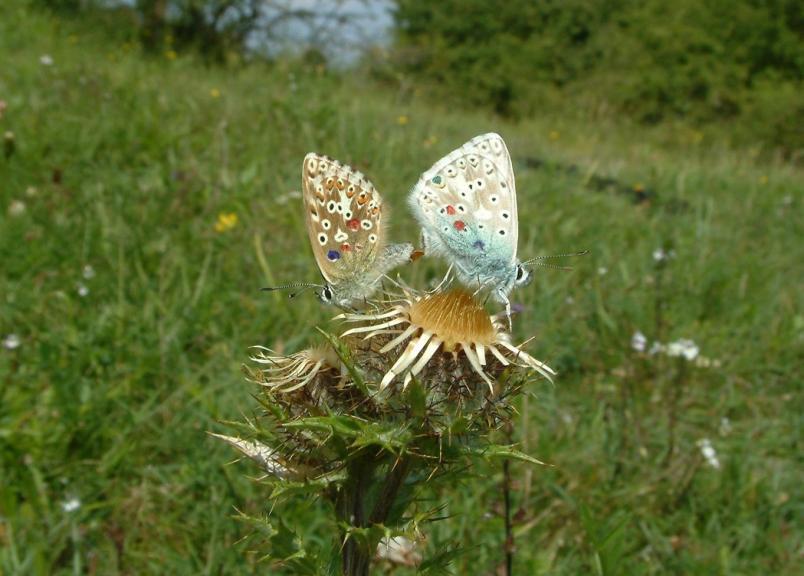
Lead supervisor: Edgar Turner, Zoology
Co-supervisor: Andrew Bladon, Zoology
This is a CASE project with The Wildlife Trust for Bedfordshire, Cambridgeshire and Northamptonshire.
Brief summary:
Using a combination of field and lab-based work, this project will investigate management options for developing more varied and resilient habitats, to help protect species from the impacts of climate change.
Importance of the area of research concerned:
Rising average temperatures and increasingly extreme climatic events are placing severe pressures on natural ecosystems worldwide. While reducing greenhouse gas emissions is a key priority, conservation management at a more local scale can also help species to cope with the impacts of temperature change. For example, research has demonstrated the key role that habitat heterogeneity can play in buffering species from the impacts of climate change. This project will work at the local reserve scale to investigate species’ selection and use of microhabitats with varying microclimatic conditions, across an assemblage of UK butterfly species. Findings will inform management of reserves to mitigate the impacts of future warming on species. The project relies on a close collaboration with the WTBCN, and data collection will include citizen science approaches, working with a network of volunteers, thereby also enhancing public knowledge and engagement with research and conservation.
Project summary :
This project will work with WTBCN staff and volunteers to assess microhabitat use by an assemblage of UK butterflies and how this varies with temperature. Field components of the project will include behavioural observations of butterflies, using methods developed in other projects, to assess butterfly choice of, and behaviour in, alternative local microhabitats, and how these change over the course of the day and across days with varying temperature. As well as making use of existing microhabitat variation across reserves, the project will also use established field experiments that have manipulated local topographic and vegetation conditions. Field work will be complemented by lab work, which will include the use of arenas, set-up to assess butterfly choice of different microclimates across changing temperature conditions and species.
What will the student do?:
The student will carry out fieldwork on WTBCN reserves, which are highly variable in topographic and vegetation conditions. Fieldwork will include direct observations of butterfly behaviour and microhabitat selection across an assemblage of >25 species. This will include following butterflies to record their behaviour and choice of perching sites at a fine scale, as well as generating random flights to compare this to. Local conditions will be assessed using both fine scale readings, as well as the use of a terrestrial lidar scanner. These data will be paired with direct fine-scale measurements of butterfly and habitat temperature, using sensitive thermocouples, as well as thermal imaging of the wider environment. The field component will also make use of replicated experimental plots, where local topography has been manipulated and where scrub management has been varied experimentally to alter microclimatic conditions. To complement field work, the student will set-up experimental arenas in the lab with varying topography, to assess experimentally the impacts of changing temperature on butterfly microhabitat choice and behaviour.
References - references should provide further reading about the project:
Bladon A, Lewis M, Bladon E, Buckton S, Corbett S, Ewing S, Hayes M, Hitchcock G, Knock R, Lucas C, McVeigh A, Menendez R, Walker J, Fayle T, Turner EC (2020). How butterflies keep their cool: physical and ecological traits influence thermoregulatory ability and population trends. Journal of Animal Ecology 89, 2440-2450
Hayes MP, Ashe-Jepson E, Bladon A, Hitchcock GE, Knock RI, Lucas CBH, Turner EC (2021) Consistent oviposition preferences of the Duke of Burgundy butterfly over 14 years on a chalk grassland reserve in Bedfordshire. Journal of Insect Conservation 25, 611–628
Suggitt AJ, Wilson RJ, Isaac NJB, Beale CM, Auffret AG, August T, Bennie JJ, Crick HQP, Duffield S, Fox R, Hopkins JJ, Macgregor NA, Morecroft MD, Walker KJ, Maclean IMD (2018). Extinction risk from climate change is reduced by microclimatic buffering. Nature Climate Change, 8 (8), 713-717
Applying
You can find out about applying for this project on the Department of Zoology page.